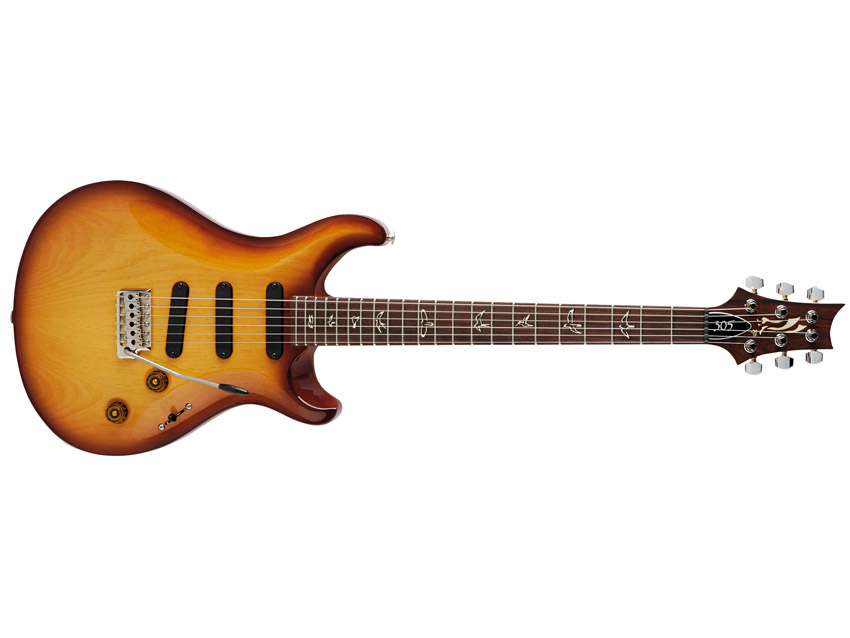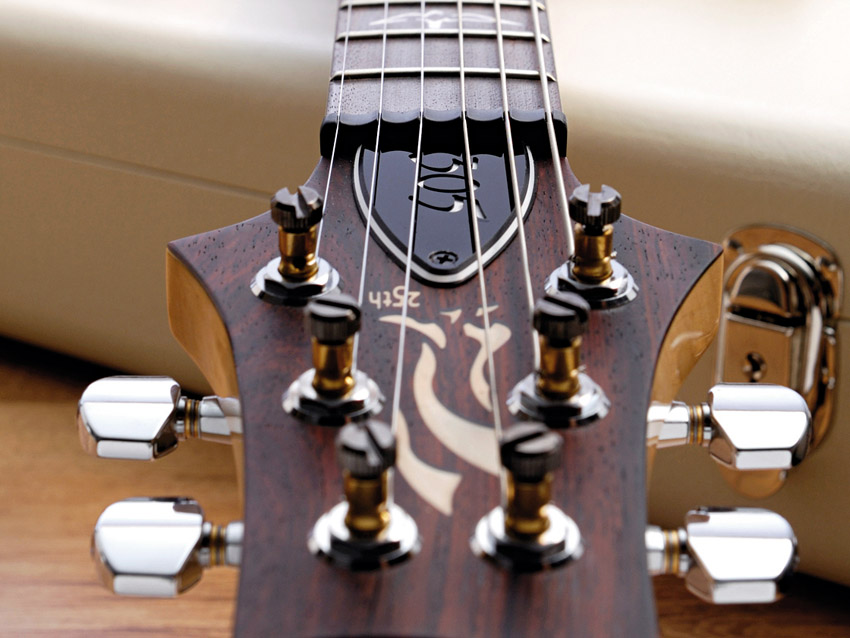MusicRadar Verdict
A union of PRS's renowned build quality and Stratocaster-inspired tones, the 305 is a superlative take on Fender's #2 son.
Pros
- +
Build. Fender-inspired features. Rich singlecoil tonality.
Cons
- -
Flat black pickup covers will divide opinion.
MusicRadar's got your back

PRS 25th Anniversary 305

PRS 25th Anniversary 305

PRS 25th Anniversary 305
The dual humbuckers that grace so many PRS guitars perhaps pigeonhole them as coming more from the Gibson side of the tone tracks. But from the first PRS guitars - such as the 25-year-old Custom, still PRS's bestselling instrument - PRS has offered single-coil tones via the original five-way switching and the later 'McCarty package'.
And don't forget the smattering of guitars over the past quarter-decade that have featured true single-coil pickups, such as the 1988 Studio, the USA-made EGs, the later 513 and the SE EG. The 305, however, could be correctly seen as PRS's first 'proper' attempt to nail a more accurate Stratocaster-like single-coil sound.
"On paper the 305 looks like a simplified version of the 513, with its five single-coils trimmed to three."
It seems PRS's artist programme was the genesis. "Basically Winn [Krozak, who heads up PRS's artist liaison] couldn't do his job without this guitar," Paul Smith told us recently.
"There were too many people that wanted that tone. It's like the player is missing the colour blue, he needs that colour to paint."
On paper, the 305 looks like a simplified version of the 513 (launched 2004). The five single-coils are trimmed to three, with a single five-way pickup selector, and the scale length is increased to a full 648mm (25.5-inches, the same as a Fender Stratocaster) over the 513's 641mm (25.25-inches). For context, most PRS guitars are 634mm (25-inches).
The body is alder, slightly thicker than standard, joined to a maple neck in a different manner from standard PRS guitars. Under the neck heel, the body sticks out to 'grab' more of the neck. This is a feature Smith conceived to increase the guitar's low end.
Other changes to narrow the gap between PRS's usual recipe and that of Fender include the use of 250k volume and tone controls and a 0.05 microfarad capacitor.
Like the neck joint, the 305 uses another of the 513's subtle features: a compensated nut. PRS has always used a compensated nut - the nut is moved slightly closer to the first-fret position to improve lower position intonation - but the 513 was the first to advertise the fact. Similarly here, its front edge is angled slightly closer to the first fret on the bass side to tweak the tuning further.
The 25th 305 comes with other celebratory features: the 25th Eagle on the rosewood-faced headstock, black/white Corian shadow bird inlays, 513/ DGT fretwire and a bone-coloured case: watch the dirt.
Sounds
Imagine a good Strat with increased low-end colour, smoother but still biting highs and a little added mid-range fatness. Then add in superb sustain, immaculate intonation and playability and an excellent in-tune vibrato system and you have a real 'supercar' version of Fender's finest.
Compared to the girth of a Singlecut, the 305 cuts, but is rarely ear-wearing. It has much of a good Strat's explosive twang on clean, reverbed amp tones, but whereas a Strat isn't always what you want for higher gained sounds, the 305 is more than happy.
The guitar cleans up very nicely (the volume control has PRS's typical treble bleed capacitor) and the tone control is, as ever, super smooth if you need to tame the highs. There's no lack of percussive bounce from the feel either.
Our only criticism is that, unlike many upper-market Strat-style guitars, the middle pickup isn't reverse-wound with reverse polarity to cut out hum on the mixed pickup positions. "You're the first to mention it," says Smith. "You're right and I'll fix it."
Built to the company's usual ultra-high standards this 25th Anniversary guitar certainly dishes-up a different flavour, or provides a different coloured crayon as Paul Reed Smith would have it.
The 305 doesn't just lean into the Fender camp, it sits right in front of the fire: an elite-level version of Fender's finest that will, by its design, not only give PRS fans that 'missing' sound but might also bring in players who like the idea of PRS, but need single-coil tones.
"The 305 has big, fat, open but a little darker single-coils," Paul Reed Smith tells us, summing up. "I've never been able to make a humbucker that sounded exactly like a single-coil… and this is interesting, some of the humbuckers on old '59 Les Pauls were so bright they almost sounded like single-coils - we don't make pickups that bright."
Our only dilemma is, between this guitar and PRS's other 25th Anniversary model - the Swamp Ash Special Narrowfield - which one we prefer, and with PRS's 2010 Experience just around the corner - usually the time when next year's models are announced - and the fact the 25th 305 is a limited run of 305 only, time is running out for us to choose. Don't say we didn't warn you!
Dave Burrluck is one of the world’s most experienced guitar journalists, who started writing back in the '80s for International Musician and Recording World, co-founded The Guitar Magazine and has been the Gear Reviews Editor of Guitarist magazine for the past two decades. Along the way, Dave has been the sole author of The PRS Guitar Book and The Player's Guide to Guitar Maintenance as well as contributing to numerous other books on the electric guitar. Dave is an active gigging and recording musician and still finds time to make, repair and mod guitars, not least for Guitarist’s The Mod Squad.
“We were arguing a lot and we were miserable”: How Green Day exceeded expectations with their most ambitious song
"There’s plenty for us guitarists to learn – and ‘less is more’ is the overriding lesson": how to play like George Harrison on The Beatles' Abbey Road
“They didn’t like his bikini underwear”: Prince’s support sets for the The Rolling Stones in 1981 are remembered as disastrous, but guitarist Dez Dickerson says that the the crowd reaction wasn’t as bad as people think










